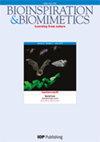实现机器人手的仿人抓取:力协同的机械实现
IF 3.1
3区 计算机科学
Q1 ENGINEERING, MULTIDISCIPLINARY
引用次数: 0
摘要
在机械手领域,手指力的协调通常是通过复杂的机械结构和控制系统来实现的。本研究从力协同的生理概念中获得灵感,设计了一种新型传输系统,旨在简化多指机械手的控制。为此,我们收集了人类在六次等距抓取任务中的手指力数据,并从连接力数据中提取了力协同(即协同加权和相应的激活系数),以探索其在力调制方面的潜力。然后,我们利用由两个弹簧滑块和五个 V 形杆组成的缆索驱动传动机构实现了两种力协同作用。具体来说,我们使用固定的协同权重来确定压缩弹簧的刚度,而滑块的位移则由时变的激活系数决定。得出的传动系统随后被用于驱动名为 SYN 手的五指机械手。我们还设计了一个运动编码器,用于选择性地激活所需的手指,从而使两个电机能够驱动各种手部姿势成为可能。对原型机的实验表明,它能成功抓取日常生活中的各种物品,在六项典型任务中,SYN 手的手指力分布与人手的力分布接近。据我们所知,这项研究是首次尝试在机械手中通过机械方式实现手指力协同调节。与具有类似功能的最先进机械手相比,本研究提出的机械手可以通过简单的位置控制在手指上分配与人类类似的力比,而无需借助额外的力传感器或复杂的控制策略。这项研究的成果可为新型拟人机械手的设计提供替代方案,从而在手部假肢和外骨骼领域展现出应用前景。本文章由计算机程序翻译,如有差异,请以英文原文为准。
Towards humanlike grasp in robotic hands: mechanical implementation of force synergies
In the field of robotic hands, finger force coordination is usually achieved by complex mechanical structures and control systems. This study presents the design of a novel transmission system inspired from the physiological concept of force synergies, aiming to simplify the control of multifingered robotic hands. To this end, we collected human finger force data during six isometric grasping tasks, and force synergies (i.e. the synergy weightings and the corresponding activation coefficients) were extracted from the concatenated force data to explore their potential for force modulation. We then implemented two force synergies with a cable-driven transmission mechanism consisting of two spring-loaded sliders and five V-shaped bars. Specifically, we used fixed synergy weightings to determine the stiffness of the compression springs, and the displacements of sliders were determined by time-varying activation coefficients. The derived transmission system was then used to drive a five-finger robotic hand named SYN hand. We also designed a motion encoder to selectively activate desired fingers, making it possible for two motors to empower a variety of hand postures. Experiments on the prototype demonstrate successful grasp of a wide range of objects in everyday life, and the finger force distribution of SYN hand can approximate that of human hand during six typical tasks. To our best knowledge, this study shows the first attempt to mechanically implement force synergies for finger force modulation in a robotic hand. In comparison to state-of-the-art robotic hands with similar functionality, the proposed hand can distribute humanlike force ratios on the fingers by simple position control, rather than resorting to additional force sensors or complex control strategies. The outcome of this study may provide alternatives for the design of novel anthropomorphic robotic hands, and thus show application prospects in the field of hand prostheses and exoskeletons.
求助全文
通过发布文献求助,成功后即可免费获取论文全文。
去求助
来源期刊

Bioinspiration & Biomimetics
工程技术-材料科学:生物材料
CiteScore
5.90
自引率
14.70%
发文量
132
审稿时长
3 months
期刊介绍:
Bioinspiration & Biomimetics publishes research involving the study and distillation of principles and functions found in biological systems that have been developed through evolution, and application of this knowledge to produce novel and exciting basic technologies and new approaches to solving scientific problems. It provides a forum for interdisciplinary research which acts as a pipeline, facilitating the two-way flow of ideas and understanding between the extensive bodies of knowledge of the different disciplines. It has two principal aims: to draw on biology to enrich engineering and to draw from engineering to enrich biology.
The journal aims to include input from across all intersecting areas of both fields. In biology, this would include work in all fields from physiology to ecology, with either zoological or botanical focus. In engineering, this would include both design and practical application of biomimetic or bioinspired devices and systems. Typical areas of interest include:
Systems, designs and structure
Communication and navigation
Cooperative behaviour
Self-organizing biological systems
Self-healing and self-assembly
Aerial locomotion and aerospace applications of biomimetics
Biomorphic surface and subsurface systems
Marine dynamics: swimming and underwater dynamics
Applications of novel materials
Biomechanics; including movement, locomotion, fluidics
Cellular behaviour
Sensors and senses
Biomimetic or bioinformed approaches to geological exploration.
 求助内容:
求助内容: 应助结果提醒方式:
应助结果提醒方式:


